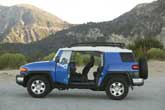Recent Articles
Popular Makes
Body Types
2007 Toyota FJ Cruiser First Drive
Growing up is overrated
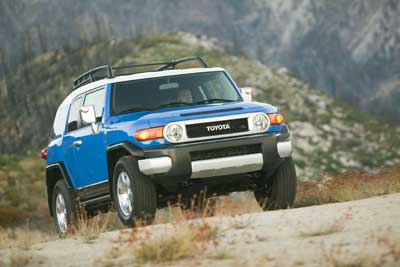
It will be a good yarn one day, and with time and countless telling, the legend will grow. Kids will hear about it, grandkids and their friends, about how so-and-so fooled the focus groups and talked Toyota management into building the 2007 Toyota FJ Cruiser. If you listen, you can actually hear the story now: how management bought into the fact that it was just a modified 4Runner with a new design and a less expensive interior, and how focus groups thought it would be a cute SUV, a trendy piece of work that would appeal to the more garish among us. They didn’t hear the part about how the FJ Cruiser rides like an actual truck-based SUV, of all things, about how it jars a bit, jostles a bit, is a bit too loud and, well, generally acts like uncle at your sister’s wedding. Go, go, GO! It’s refreshing when an automaker doesn’t put leather inside a cab because a truck isn’t supposed to have leather. It’s refreshing when an automaker keeps it real, builds a truck to do truck things, and doesn’t try to attract people who just will never, ever, get the bright blue paint and the white roof. The FJ Cruiser is the coolest, most unapologetic vehicle ever built by Toyota, a bold SUV not for everyone – but it could be, given its off-road prowess, capable engine, interesting interior and exciting design. About that design: that’s another thing that’s refreshing - when an automaker keeps to the original concept of a car and creates a really cool vehicle. Not so refreshing is a back seat built for no one – unless your name is Grocery Bag or Brief Case. There’s a good amount of legroom, true, but the setup makes you feel as though you're sitting in a dark hole. Also a bit stale are the suicide doors that are a bad old idea on a new vehicle. Ultimately, to those who either don’t get the FJ Cruiser - or will never take it off-road - we kindly request that you purchase a RAV4, with the new V6. A nice vehicle, a safe, unassuming SUV, the RAV4 is something your mother-in-law will approve of, the kind of car she may even smile over. Pull up in an FJ Cruiser, however, and the first thing out of the old hag’s mouth will be something about growing up or having an affair. So what. Growing up is overrated anyway.
Model Mix
Model Mix Put it all together, and it would seem hard to beat a base model four-wheel-drive 2007 Toyota FJ Cruiser with its full-time transfer case and six-speed manual transmission, for numerous reasons starting with off-road capability, fuel economy and performance. Beyond the choice of off-road capability, manual or automatic transmission and stereo options, the 2007 Toyota FJ Cruiser is an out-of-the box, straightforward vehicle without too many choices to consider before purchase. That’s by design, of course, as the base offerings should sell in the low-to-mid $20,000 range when they reach dealer lots in March 2006. That should make the FJ affordable to a younger set of people who find the white roof and bold look attractive. Let’s face it: if you like the style of the RAV4, the FJ Cruiser is probably a bit too spicy for your palate, and you’re probably looking for more choices in your vehicle. As for the FJ Cruiser, there’s only one model with three basic variants: a base rear-wheel-drive with a five-speed automatic transmission; a part-time four-wheel drive with a choice of the automatic transmission or a six-speed manual; and a full-time four-wheel-drive model that comes with the six-speed manual transmission. All 2007 Toyota FJ Cruisers are powered by a 4.0-liter engine that makes 239 horsepower and 278-lb. ft. of torque. Standard equipment on all models include 17-inch black wheels fitted with P265/70R17 tires, air conditioning, power windows and door locks, black water-resistant seats, an eight-way manually adjustable driver seat, a four-way manual passenger seat, a tilt steering wheel, four cup holders (with two bottle holders), a rear-window defogger, and fuel-tank skid plates. All models come with a rear-door-mounted full-size spare, mudguards, tow hooks front and rear, Vehicle Stability Control (VSC) with traction control (TRAC), and an antilock braking system (ABS). An automatic limited-slip differential is standard on two-wheel-drive models. Other goodies include an audio system with six-speakers (including two ceiling speakers), two-stage driver and front passenger airbags, and a remote hood release. Color choices for the 2007 Toyota FJ Cruiser include Titanium Metallic, Black Diamond, Black Cherry, Sun Fusion, and Voodoo Blue. For the most part, options come by way of three packages. The Convenience Package includes keyless entry, cruise control, power side-view mirrors with image lights, daytime running lights, privacy glass, a rear window wiper and rear parking sonar. Upgrade Package One adds A-TRAC (an active off-road traction control system), a rear locking differential, a compass, an inclinometer, a temperature gauge, an in-dash six-disc CD changer with a 400-watt inverter, 17-inch alloy wheels, a leather-trimmed steering wheel with integral controls for the stereo and cruise-control, a metal-colored shift lever, and interior door-trim inserts keyed to the vehicle's exterior color. Upgrade Package Two adds a rear subwoofer. To order either Upgrade Package, the Convenience Package must first be purchased. Individual options include side and curtain airbags, 17-inch alloy wheels, a rear locking differential, and running boards. At press time, pricing was not available for individual options or option packages. Put it all together, and it would seem hard to beat a base model four-wheel-drive FJ Cruiser with its full-time transfer case and six-speed manual transmission, for numerous reasons starting with off-road capability, fuel economy and performance. Add side-curtain airbags and running boards, and you’ve got yourself a stylish, rock-clambering beast that lives up to the heritage of the FJ name.
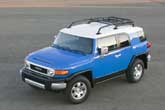
Nuts and Bolts
Nuts and Bolts The 2007 Toyota FJ Cruiser’s powertrain is bolted onto a boxed-steel ladder frame, essentially a modified 4Runner platform. The suspension set-up is also based on the 4Runner, with an independent, double wishbone front and a solid rear axle with coil springs. It’s almost as if Toyota took the guts of its successful 4Runner utility vehicle, tweaked it a bit, and shoehorned on a new exterior and interior to make the 2007 Toyota FJ Cruiser. Of course, it’s not that simple. But there are a number of similarities between the two, thanks to the fact that the FJ Cruiser is built on a modified version of the 4Runner platform. For starters, there’s the engine, a 4.0-liter V6 that produces 239 horsepower at 5,200 rpm and 278 lb.-ft. of torque at 3,700 rpm, and can tow up to 5,000 lbs. This same V6 engine also drives the Tundra and Tacoma pickup trucks, and has proven dependable over time. The EPA rates the FJ Cruiser's city/highway fuel efficiency at 18/22 mpg for the two-wheel-drive, and 17/21 mpg for the four-wheel-drive automatic. One of two transmissions is mated to the engine: a six-speed manual or a five-speed automatic. The automatic has what Toyota calls Artificial Intelligence (AI) Shift Control, which varies the transmission's shift pattern based on road conditions and driver input. While there was no noticeable change in the shift pattern during a brief test drive with the automatic transmission, this feature could result in slightly improved fuel economy and better response during acceleration, according to Toyota. Automatic transmission models get a part-time transfer case with shift-on-the-fly capability. The six-speed manual transmission is available on four-wheel-drive models, and it proved easy to use during on-pavement and off-road testing. Manual transmission models have the 4Runner’s two-speed transfer case, featuring a Torsen differential with locking mechanism. The transfer case distributes the engine's power 40 percent to the front and 60 percent to the rear. When locked, it distributes power front to rear in a 50/50 split. The manual also has a clutchless start feature that is especially handy during off-road maneuvers. All two-wheel-drive FJ Cruisers come with an automatic limited-slip differential operated by the vehicle’s traction control system. The system provides improved traction to the rear wheels under slippery driving situations. The 2007 Toyota FJ Cruiser’s powertrain is bolted onto a boxed-steel ladder frame, essentially a modified 4Runner platform. The suspension set-up is also based on the 4Runner, with an independent, double wishbone front and a solid rear axle with coil springs. Steering is handled by a rack-and-pinion setup that controls 17-inch wheels, clad with P265/70R17 tires. Standard brakes are 12.6-inch discs up front and 12.3-inch discs in back.
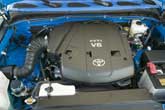
Design
Design According to Toyota, the point of the 2007 FJ Cruiser is to bring back the rugged “spirit” of its famed FJ40 utility vehicle. They do a good job of it, too, with such historical design cues as the round headlights, vertical front windshield and the TOYOTA badge on the front grille. Toyota will tell you that they expect 90 percent of the 2007 FJ Cruisers sold to be of the four-wheel-drive variety. And while they’re surely correct, that still leaves at least 10 percent of future FJ owners in it for nothing more than the funky white roof, bold color and broad stance. Heck – if you can’t drive off-road, you may as well look good anyway, or at least be colorful and different. As one of the few vehicles that has made it to production with its concept design intact, that about sums up the 2007 Toyota FJ Cruiser, which sports a dome as white as Mt. Whitney and a color palate that will make Camry designers run and hide, with broad shoulder and a face that thousands of young adults – you attach the age - will absolutely love. There’s no mistaking one of these creatures, no sir, not up front or in back. In truth, the design – inside and out – is what’s most notable about the FJ, as the mechanicals are, well, from the 4Runner platform, even though the FJ is about 11 inches shorter and has a four-inch shorter wheelbase. The platform is known as Toyota’s HiLux truck platform, on which the Tacoma is also built. You’d never guess it by looking at it, or sitting in it, as the FJ Cruiser is unlike anything Toyota currently sells in North America. It’s not just different for the sake of it, however, as there is an actual historical tint to the vehicle’s design. According to Toyota, the point of the FJ is to bring back the rugged “spirit” of its famed Land Cruiser FJ40 utility vehicle. They do a good job of it, too, with such historical design cues as the round headlights, vertical windshield and the TOYOTA badge on the front grille. Other interesting design elements are the wrap-around rear corner windows. It’s a decidedly look. Is it okay if we say that, Mr. Mays? Given that the FJ is Toyota’s first real retro car debut, woe be the domestic automaker who thought that the imports didn’t have any of these up their sleeves. And woe be the local Hummer H3 dealer in town, for now he has a direct competitor on style that wears a Toyota badge, one that has more power and matches up among the rocks and stream beds. The historical funk-a-delic theme continues on the inside, with white-faced gauges, large control knobs, charcoal-colored water-proof seats, and access doors that add to the character of the FJ – but prove to be, ultimately, a bit of a hassle to use on a regular basis. Though the back seat is large and comfortable, with plenty of legroom, this is really not a Mommy and Me kind of SUV – though plenty of Moms out there may well try to make it one. Like the exterior, the interior is unlike anything currently sold by Toyota. Think of the FJ as a cross between the Nissan Xterra and the Hummer H3: big, bold and full of utilitarian design that will A.) come in useful should you find yourself off-road and B.) make you feel really cool and neat should you stay on pavement.
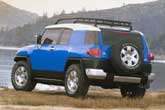
Safety and Technology
Safety and Technology The tricks and technology on the 2007 Toyota FJ Cruiser continue beyond safety and the nuts and bolts of the vehicle to include features such as three wiper arms on the vehicle's wide, front windshield. You’ll also notice cargo-net hooks, including floor-mounted cargo tie-down anchor points, which hint at one of the FJ’s main competitors, the Nissan Xterra. Like all Toyota SUVs, the 2007 FJ Cruiser is a STAR. That’s STAR as in Toyota’s industry leading safety system, which includes Vehicle Stability Control (VSC), Traction Control (TRAC), an Antilock Braking System (ABS), Electronic Brake-force Distribution (EBD) and Brake Assist. You don’t have to remember all the acronyms. Just remember that EBD distributes the braking force between the front and rear wheels, based on driving conditions, and that TRAC keeps the tires from slipping on slippery stuff. The VSC system assists the driver in maintaining course by attempting to control skids, and Brake Assist helps you apply maximum pressure more quickly during emergency braking situations. ABS keeps your wheels from locking up in an emergency situation. Toyota also includes dual-stage front driver and passenger airbags on the 2007 FJ Cruiser. As far as optional safety equipment goes, there’s not much aside from side curtain airbags all around, front seat side-impact airbags, and daytime running lights. Yeah. Remember that - or just keep in mind that few other automakers offer the level of standard safety technology that Toyota currently does on its SUVs, technology that may actually save lives by keeping these large and tall behemoths on the road in most types of conditions. Of course, there’s no accounting for reckless driving, and no amount of electronic wizardry will keep a fool connected to the road in a rainstorm. All in all, the final arbiter of safety is you, behind the wheel, with a little help from our friends at government and insurance crash-test centers. Busted fenders aweigh! The tricks and technology on the FJ Cruiser continue beyond safety and the nuts and bolts of the vehicle to include features such as three wiper arms on the vehicle's wide, front windshield. You’ll also notice cargo-net hooks, including floor-mounted cargo tie-down anchor points, which hint at one of the FJ’s main competitors, the Nissan Xterra.
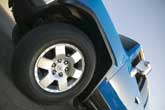
Driving Impressions
Driving Impressions Equipped with a nice V6 engine courtesy of the 4Runner/truck line, the motor makes 239 horsepower and 278 pound-feet of torque, power that feels right at home pulling the 2007 Toyota FJ Cruiser down the road. This is not the sort of Toyota you’re used to driving. Louder, with more rattles, it is the roughneck Toyota that doesn’t care if you and your rear get a little jostled. In other words, Highlander this ain’t, bubba, and it's a good thing, too: to make the 2007 FJ Cruiser a smooth riding, quiet suburban machine would be like dressing a marine in a tutu. It seems clear to us that Toyota’s goals with the 2007 FJ Cruiser were power, off-road prowess, and style inside/out. Then, maybe, way down at the bottom of the chief engineer’s scratch pad, something about making it quiet and smooth, and meeting Toyota’s Golden Rule #1: make cars so vault-like that competitors scratch their heads and wonder, how? Of course, Toyota being Toyota, they can’t help but try to make even this, the ultimate SUV , well, perfect. So they put speakers in the roof. All that mumbo-jumbo talk of technology? Yeah, yeah. Of course it’s advanced. But then maybe it’s as advanced as one Toyota engineer saying to another: Music drowns out a lot of sins, though the 4.0-liter V6 engine is hardly a crime. A nice engine courtesy of the 4Runner/truck line, the V6 makes 239 horsepower and 278 pound-feet of torque, power that feels right at home pulling the FJ Cruiser. It’s nicely powered for off- and on-road driving, and, according to Toyota, can tow up to 5,000 lbs. That’s more power than a Hummer H3, though slightly less than a new Xterra. Though we didn’t get much time with the FJ Cruiser off the paved road – and the course we did attempt was generally beginner grade – the FJ Cruiser reportedly can do whatever you ask of it off-road. Check back later for a more detailed off-road analysis, however, as we flog the thing up the sides of mountains and through deep, cold rivers. We may even cross the Mohave Desert in the thing, if we’re up for a road trip, because Toyota makes us feel as though the FJ Cruiser is invincible, and no one in the business has said otherwise...yet.
The highway is a different - yawn - story. Let’s face it: you’re either buying the FJ because you want to go off-road, or because you want to pretend that you go off-road. Either way, Bunky, you don’t care what it drives like down Main Street, right? You should. Because without the right combination of braking capability and power, of steering response and feel, the opportunity for accidents goes way up. So in the things that matter, the FJ Cruiser seems to do fine. Its wide track gives it a solid feel for the pavement, the steering is responsive, and the engine is a nice match. The stand-up straight windshield and command seating up front give the driver a feeling of control, though people in the back are left with the impression that they’ve just stumbled into a dark, plastic place. And about loading those people: the suicide doors are a pain. Try letting someone out of the back while still buckled in the front. It’s a real squeeze, which brings us right back around to the 2007 Toyota FJ Cruiser: if you want it to be your main car squeeze, buy the six-speed manual, get the 4x4 if you can, and try to avoid sitting in the back seat.
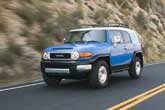
Off-Roading
Off-Roading The Jeep Wrangler is tough company for the 2007 Toyota FJ Cruiser. The Wrangler is appealing on difficult terrain but it’s lousy and loud on the highway and has nowhere near the rear cargo room of the FJ. I’d prefer the FJ on a road trip loaded up with gear and buddies. Toyota set up a truly technical 4x4 course on the 3,000-acre campus of Michelin’s North American proving grounds in South Carolina, and after motoring along a wooded two-track and navigating an obstacle course, there was no doubt that the new 2007 Toyota FJ Cruiser has been engineered for the backcountry and beyond.
Toyota’s competition in this segment is stiff, and includes the Hummer H3, Jeep Liberty, Jeep Wrangler, and Nissan Xterra. These are not simply lifestyle-oriented, “soft-roader” SUVs, but vehicles designed with the dual mission of tackling tough and technical terrain, as well as traveling the tarmac.
While the FJ’s wild and wacky exterior is like none other, that could also be said of its throwback interior which is equipped with chunky controls that can be easily twisted by a fully-gloved hand. Consider that the FJ’s interior is completely waterproof and it’s clear that this is one SUV designed for down and dirty driving. Clever standouts include the storage drawers on the top of the dash; the full-sized glove box; the triplet of wipers on the windshield; and the household adapter plug in the back.
The FJ’s boxed ladder frame is based on Toyota’s 4Runner. The independent front suspension allows 7.9 inches of wheel travel, while a four-link solid rear axle with coil springs yields 9.1 inches of travel in back. Since the body of the utilitarian FJ Cruiser is 11 inches shorter than that of the 4Runner, approach and departure angles have been greatly improved, especially since the wheelbase has only shrunk by four inches. Combined with 9.6 inches of ground clearance and standard P265/70R17 (32-inch) tires, the FJ Cruiser achieves an approach angle of 34 degrees and departure angle of 30 degrees, and effortlessly conquered the off-camber tasks on the technical 4WD course.
I selected the manual transmission model for off-road testing and found the clutch and throttle pedals easy and predictable to use. Missing from the FJ Cruiser is the Hill Descent Control system found on Toyota’s more upscale and costly models, but its low-range gearing keeps it at a navigable crawl speed for all but the steepest of descents, when the extra slowing power of the brakes was needed. Steering is weighted and geared to handily maneuver the FJ, providing nimble response despite its deceptively large dimensions. Plus, during a three-point turn, the FJ exhibited no axle binding and got flipped around in a relatively tight space.
Our only complaints centered on the jouncy ride that sometimes came with higher speeds – and particularly rugged off road terrain – and rear visibility issues. A gentle tap of the brakes quieted the suspension and smoothed the ride, but there was no resolving the view to the rear. The tall and narrow exterior mirrors provided poor rearward visibility, a problem compounded by the FJ’s thick C-pillars and small rear glass.
Unquestionably, the 2007 Toyota FJ Cruiser is a real off-roader, even if the numbers aren’t impressive on paper. For example, Hummer’s H3 on 32-inch tires and with 9.1 inches of ground clearance allows for approach up to 38 degrees and departure of 36 degrees. What’s more, the optional 33-inch tires on the Hummer, approach and departure angles are even more impressive at 40/37. Slightly shorter overhangs account for the advantage, as the difference between overall length and wheelbase is 74.8 inches on the Hummer, and 78 inches on the FJ.
Jeep goes even farther, as both the Wrangler Rubicon and long-wheelbase Wrangler Unlimited Rubicon manage steep approach angles of 44.9 and departure angles of 33.9. Even the standard Wranglers offer 42-42.2 angles of approach and 31.4-31.5 angles of departure, while clearing 8.9 inches.
Jeep’s less aggressive, but still competent, Liberty boasts a ground clearance of 9-9.4 inches depending on the model, and features approach and departure angles of 34.6-37.2 and 31.2-31.5, respectively. Nissan’s Xterra stands 9.5 inches over the terrain with approach/departure angles of 33.2/29.4 degrees, positioning the vehicle much closer to the FJ Cruiser.
As the numbers suggest, the Nissan Xterra may be the FJ’s closest competitor, at least in terms of character. Both use 4.0-liter V6 engines with plenty of torque (278 lb.-ft., Toyota; 284 lb.-ft., Nissan). The Nissan’s 265 horses trump the 239 provided by Toyota, but both feature either a six-speed manual or five-speed automatic. Jeep offers an inline six-cylinder engine displacing four liters in the Wrangler, but it outputs only 190 hp and 235 lb.-ft. of torque. An inline engine is also found under the Hummer’s hood, with five cylinders yielding 220 hp and 225 lb.-ft. via 3.5 liters of displacement. Jeep Libertys get either a 210 hp/235 lb.-ft. 3.7-liter V6 or a torquey 2.8-liter turbodiesel delivering 295 lb.-ft. and 160 horses.
Eight-inch differentials are used at both ends of the 4WD FJ Cruiser, and the rear unit locks. Wrangler Rubicons use locking differentials both front and rear, while the Xterra – appropriately equipped – gets only a locking rear unit. Both the Nissan and Toyota employ some form of vehicle stability control, although Xterras may optionally include Hill Descent Control and Hill Start Assist.
The Jeep Wrangler is tough company for the FJ, which is like a Wrangler in Hummer clothing. It’s capable and nimble for its size, but tall and gangly in its sheetmetal and proportions. The Wrangler is more of a “runabout,” with a short wheelbase and size that makes it appealing in certain circumstances and on specific terrain – like the tight and narrow stretches of the Rubicon Trail. The Rubicon Wrangler, with its off-roader’s dream package including front and rear locking diffs and the crawl ratio of a mountain goat, would be my first choice among these players to take on the extreme rock climbs in Moab, for instance – and I've done so. But, it’s lousy and loud on the highway and has nowhere near the rear cargo room of the FJ. I’d take the FJ on a road trip loaded up with gear and buddies and then go play in the dunes – or camp at Pismo Beach. –

FAQs
FAQs Given its roots as a modified 4Runner, the FJ’s off-road prowess is hardly a surprise. What is an eye-opener, however, is how close Toyota designers were able to come to the actual concept model. From the near-outlandish exterior styling to the spartan interior and FJ40 heritage cues, the FJ Cruiser is unlike anything Toyota has built in a long, long, time. No. All FJ Cruisers come with a white roof, which creates a dynamic look when combined with the bright exterior colors. They're pretty much a hassle. Case in point: don’t try to open up the door and let someone out while wearing your seatbelt! While the doors provide more entry/exit room for back seat occupants, front seat passengers still must get out to make way. Given its roots as a modified 4Runner, the FJ’s off-road prowess is hardly a surprise. What is an eye-opener, however, is how close Toyota designers were able to come to the actual concept model. From the near-outlandish exterior styling to the spartan interior and FJ40 heritage cues, the FJ Cruiser is unlike anything Toyota has built in a long, long, time.
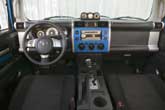
Specifications
Specifications Key competitors of the 2007 Toyota FJ Cruiser include the Dodge Nitro, Honda Element, Hummer H3, Jeep Liberty, Jeep Wrangler, Kia Sorento, Nissan Xterra, and Suzuki Grand Vitara. Test Vehicle: 2007 Toyota FJ Cruiser Price Range: mid-$20,000 - $30,000 (estimated) Engine Size and Type: 4.0-liter V6 engine Engine Horsepower: 239 at 5,200 rpm Engine Torque: 278 lb.-ft. at 3,700 rpm Transmission: Five-speed automatic; six-speed manual Curb Weight, lbs.: 4,050 (2WD AT); 4,290 (4WD M/T); 4,295 (4WD A/T) EPA Fuel Economy: 18/22 (2WD AT); 16/19 (4WD MT); 17/21 (4WD AT) Length: 177.6 inches Width: 74.6 inches Wheelbase: 105.9 inches Height: 70.9 inches Legroom (front/rear): 41.9 inches/31.3 inches Headroom (front/rear): 41.3 inches/40.3 inches Max. Seating Capacity: 5 Max. Cargo Volume: 66.8 cubic ft. Max. Payload: 1,325 lbs. Max. Towing Capacity: 5,000 lbs. Ground Clearance: 8.7 (2WD); 9.6 (4WD) Competitors: Chevrolet Equinox, Dodge Nitro, Ford Escape, Honda CR-V, Honda Element, Hummer H3, Hyundai Santa Fe, Hyundai Tucson, Jeep Commander, Jeep Grand Cherokee, Jeep Liberty, Jeep Wrangler, Kia Sorento, Mazda Tribute, Mitsubishi Endeavor, Mitsubishi Outlander, Nissan Xterra, Pontiac Torrent, Saturn VUE, Subaru Forester, Suzuki Grand Vitara, Toyota 4Runner, Toyota RAV4.
Photos courtesy of Toyota Motor Corp.
